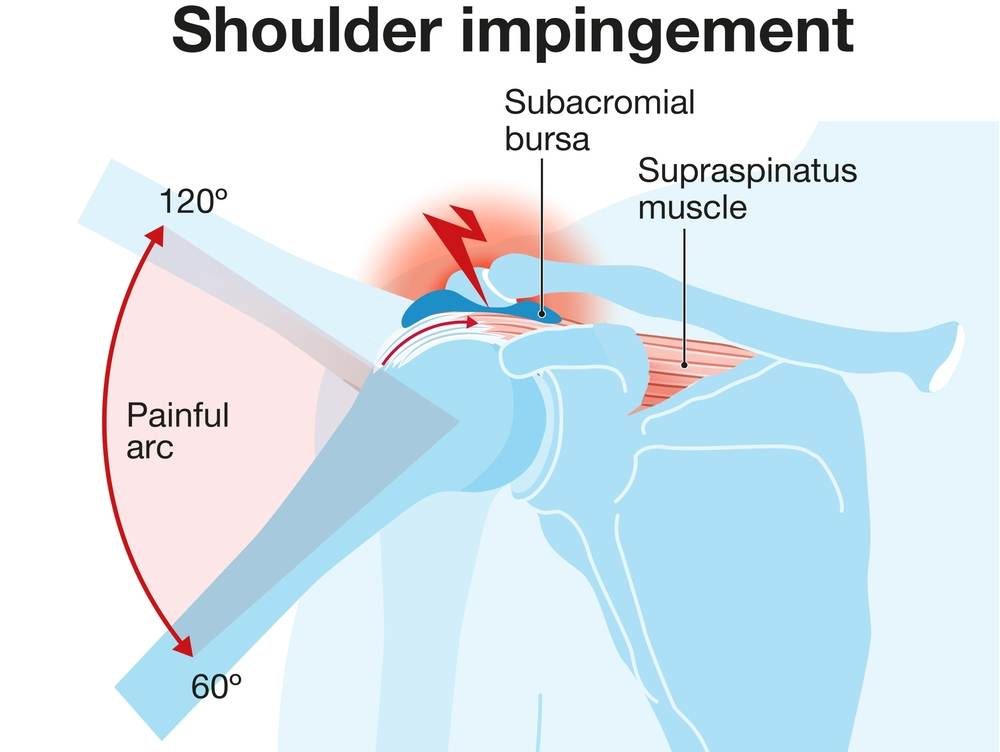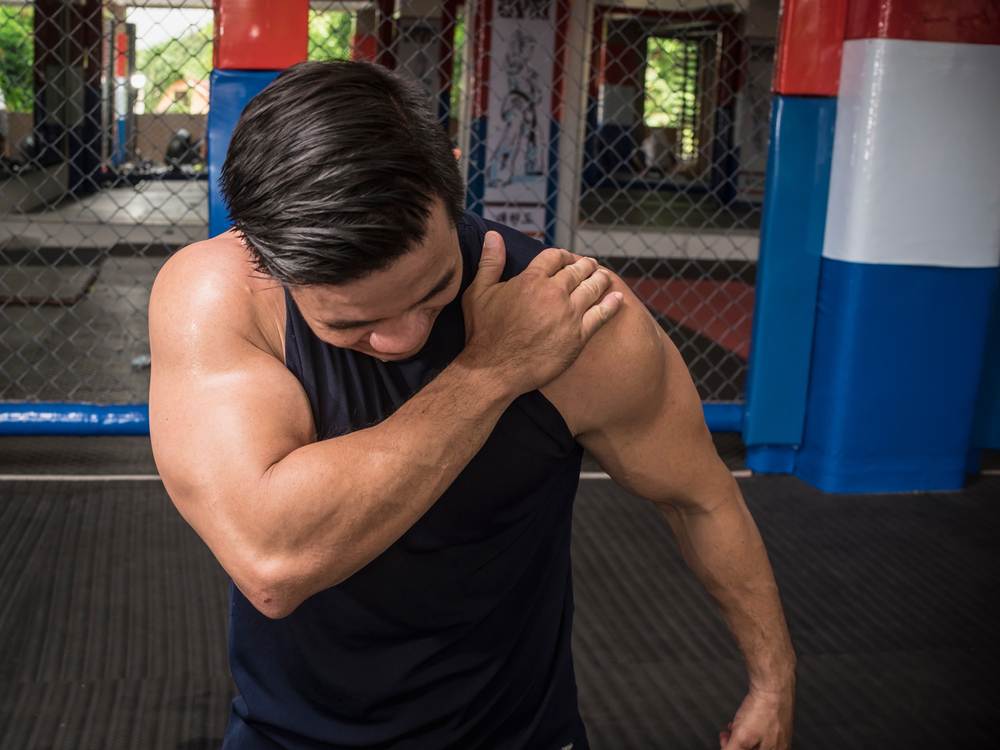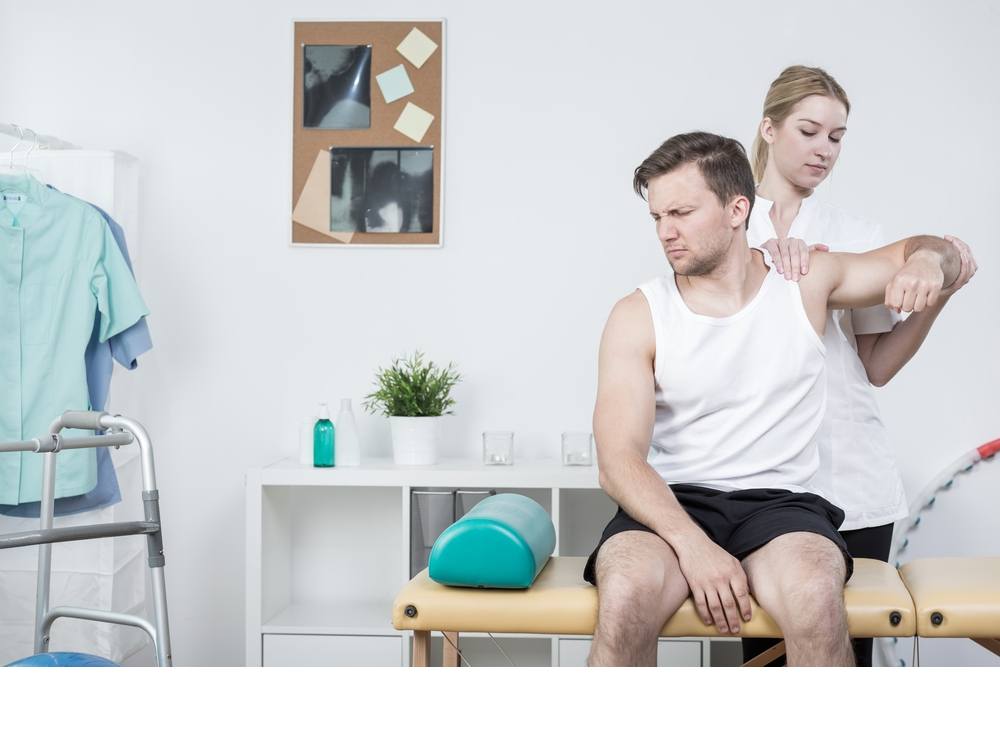 While you may think of your shoulder as the simple curve that sits atop your arms, it is actually a complex series of joints, tendons, and muscles that support a huge range of motion. Any damage to these components can cause pain and trouble moving your shoulder properly, harming your quality of life and your ability to work. While the entire shoulder is vulnerable to injury, the rotator cuff is one of the most commonly affected. Irritation of the rotator cuff is also known as shoulder impingement syndrome and may require medical treatment.
While you may think of your shoulder as the simple curve that sits atop your arms, it is actually a complex series of joints, tendons, and muscles that support a huge range of motion. Any damage to these components can cause pain and trouble moving your shoulder properly, harming your quality of life and your ability to work. While the entire shoulder is vulnerable to injury, the rotator cuff is one of the most commonly affected. Irritation of the rotator cuff is also known as shoulder impingement syndrome and may require medical treatment.
Anatomy of the Shoulder
Your shoulder is composed of three bones: the humerus or the upper arm bone, the shoulder blade or scapula, and the collarbone or clavicle. These bones meet at the shoulder to facilitate the movement of the arm. The shoulder socket contains a series of muscles and tendons that form a cover around the head of the humerus, attaching it to the shoulder blade. This is known as the rotator cuff, and its purpose is to keep your arm in the shoulder socket. A lubricating sac called the bursa is between the rotator cuff and the bone on the top of your shoulder (acromion). The bursa lets the rotator cuff’s tendons glide freely when you move your arm.
The rotator cuff is a common source of many shoulder conditions, including tendinitis when irritated or damaged and bursitis when the bursa is swollen with fluid. Another common condition is known as shoulder impingement syndrome, which occurs when you raise your arm up to shoulder height and the space between the acromion and rotator cuff narrows too much. When this happens, the acromion can rub against the tendon and the bursae, causing irritation and pain.
Causes of Shoulder Impingement Syndrome
The people most commonly impacted by shoulder impingement syndrome are young athletes, especially those who use their arms overhead. This includes swimmers, baseball players, and tennis players. People who participate in repetitive lifting or overhead activities are also at risk, such as those who do construction, hang wallpaper, or paint for a living. It is also possible for a minor injury to become shoulder impingement, especially in middle-aged and older people.
Anatomical differences can also lead to this pain. Some people are born with an acromion that is not flat, and you can also develop age-related bone spurs on the acromion.
Signs of Shoulder Impingement Syndrome
 Shoulder impingement typically appears as local swelling and tenderness in the front of the shoulder, as well as pain and stiffness during movement. Lifting your arm above your head is the most likely to cause these issues, though lowering it can also contribute. Usually, only one shoulder is affected, though it can appear in both for some people.
Shoulder impingement typically appears as local swelling and tenderness in the front of the shoulder, as well as pain and stiffness during movement. Lifting your arm above your head is the most likely to cause these issues, though lowering it can also contribute. Usually, only one shoulder is affected, though it can appear in both for some people.
Symptoms will typically begin mildly, and many people do not seek treatment because it is easy to ignore. Early symptoms include:
- Minor pain, present both during activity and during resting periods
- Pain that radiates from the front of the shoulder down to the side of the arm
- Sudden pain with lifting and reaching movements
- Pain when throwing or serving a ball, for athletes
Without treatment, symptoms will worsen and can lead to pain at night, a loss of strength and motion of the arms, and difficulty doing activities that place the arm behind the back, like buttoning a shirt. If the pain is brought on suddenly, the shoulder may also become extremely tender and have limited and painful movement.
If the injury is present for a long period without treatment, the tendon could be completely split in two and turn into a rotator cuff tear. This would cause symptoms like significant weakness and difficulty elevating the arm.
To avoid more serious symptoms and injuries, it is important to seek medical care at the first signs of shoulder impingement pain.
Diagnosing Shoulder Impingement Syndrome
If you present with shoulder pain, a doctor will be able to talk with you to understand if the rotator cuff or another area seems to be the root cause. They will first discuss your symptoms, medical history, lifestyle and recreational activities, and any other relevant information to help them understand your case.
Your doctor will also perform a physical examination of your shoulder, first looking for any tender or visibly deformed areas. They will also measure the range of motion in the shoulder by asking you to move your arm in several directions and testing the strength during movement. To rule out other injuries, the doctor may examine the rest of your shoulder joint and neck. This exam can help eliminate conditions like arthritis or a pinched nerve as the cause of your symptoms.
To confirm your diagnosis, a doctor may use imaging tests that help give them more information.
These include:
- X-Rays: These scans show your bones rather than the soft tissue of your shoulder and, therefore, will not typically show rotator cuff issues. However, they may be used to identify a small bone spur or rule out breaks. A special kind of x-ray called an outlet view can be used to show these bone spurs on the front edge of the acromion.
- Magnetic resonant imaging (MRI): MRIs can create detailed images of soft tissues, including the tendons in your rotator cuff. They can also show fluid or inflammation in the bursa and rotator cuff to help understand the root cause of your pain. If it is present, they may also highlight tearing to the rotator cuff that has occurred after prolonged injury.
Your doctor should be able to use these techniques to identify the cause of your pain and diagnose you with shoulder impingement syndrome. This will allow you to create a treatment plan that properly addresses the root cause of your pain.
Treating Shoulder Impingement Syndrome
 The goal of any treatment plan will be to restore function to the shoulder and reduce pain as much as possible. For some people, this will also include the ability to return to occupational and recreational activities that were previously possible.
The goal of any treatment plan will be to restore function to the shoulder and reduce pain as much as possible. For some people, this will also include the ability to return to occupational and recreational activities that were previously possible.
Non-Surgical Options
The majority of shoulder impingement cases will be treated with non-surgical options. These can take some time to be effective but offer a gradual return to function or significant improvement.
Early treatment options can include:
- Rest: You will likely be advised to rest your shoulder as much as possible. This may include modifying or avoiding certain activities, like sports or overhead lifting. Continuing these activities could worsen your condition or prevent healing.
- NSAIDs: Non-steroidal-anti-inflammatory drugs like ibuprofen and aspirin are available over the counter and can be used to manage pain as well as reduce inflammation. These should always be used under the guidance of your doctor.
- Physical therapy: Working with a physical therapist can be the key to restoring normal motion to your shoulder. The therapist may provide stretching exercises to improve your range of motion. A common stretching routine could include stretching the posterior capsule to help with tightness when reaching behind your back. Once your pain has improved, you can begin working on a program to strengthen the rotator cuff and avoid future injury.
- Steroid injections: If pain is not managed with the above treatments, your doctor may recommend steroid injections. A combination of local anesthetic and a cortisone preparation can be injected into the shoulder behind the bursa to reduce inflammation and pain.
Shoulder impingement usually takes about three to six months to heal with non-surgical treatment, though severe cases could take up to a year. However, it is typically about four weeks before you can begin returning to normal levels of activity under the guidance of your doctor and physical therapist.
Surgical Treatment
When non-surgical treatment doesn’t relieve pain, your doctor may recommend surgery as an option for managing shoulder impingement. The goal of surgery is to create more space for the rotator cuff by removing the inflamed areas of the bursa and potentially part of the acromion. This procedure is known as a subacromial decompression and is typically performed using an arthroscopic technique.
With this technique, thin surgical instruments are inserted via two or three very small puncture wounds around the shoulder rather than an open incision. Your doctor uses these tools to insert a fiberoptic scope connected to a television camera, then guides them using a video monitor to examine your shoulder and remove bones or soft tissue.
At the time of surgery, your surgeon may also address other conditions besides the impingement. Your surgeon can also address arthritis between the clavicle and acromion, inflammation of the biceps tendon, or a partial rotator cuff tear.
After surgery, you may need to use an arm sling for a while to allow for early healing. Once you feel more comfortable, your doctor will remove the sling and direct you to begin exercises and basic arm use. A full rehabilitation program will be based on your needs, and it can take up to a year for full relief from pain.
Can I Prevent Shoulder Impingement Syndrome?
While shoulder impingement surgery is sometimes caused by an injury, a car accident, or genetic factors out of our control, it is more commonly related to our daily activities and motion. Athletes often train to avoid these types of injuries, but anyone can implement strategies and therapy to help prevent the condition from developing.
Gradual Training
One of the main reasons athletes develop this condition is doing too much too soon. Starting a new workout routine or training plan can be great, but it is important to ramp up gradually to help your body acclimate to its new routine. Some workouts offer an “on-ramp” solution, or your athletic trainer may help you to gradually increase the intensity of your workout. Being intentional about your movement can help your shoulder adjust more easily and avoid injury.
Balance Movement
Muscle imbalance can be a huge contributing factor in shoulder impingement, as the muscles along the back of the shoulder blade can be neglected during training that focuses on developing muscles in the front of the shoulder or the chest. This can cause an unstable shoulder blade and impact the way your shoulder works, causing inflammation. An easy way to address this is to be sure that for every upper body “push” exercise you do, add a “pull” exercise- so if you do a pushup, do a row as well.
Focus on Your Posture
Even if you don’t do a lot of exercising or training, poor posture can cause shoulder impingement for everybody. Slouching forward in an office chair or when using a cell phone can cause our shoulders to round forward, reinforcing bad shoulder movement that causes inflammation. Focus on keeping your shoulder back, chest open, and shoulder blades stable to improve your posture and protect your shoulders.
Manage Inflammation
If you do notice a little inflammation in your shoulders, you can take quick action to eliminate it before it causes more severe issues. After working out or hurting your shoulder, apply ice for 20 minutes to help with swelling. Proper rest between activities and a good night’s sleep can also help reduce inflammation.
Move Correctly
If you participate in many overhead activities or sports, using the right body mechanics can be extremely important for maintaining shoulder health. This can be especially important if it is a part of your work and you need to be able to perform the movements for a long time. You can work with an athletic trainer or a physical therapist to analyze your form and develop a routine that reduces your chance of injury.
Whether you have injured your shoulder already or want to prevent it from happening in the future, AICA College Park is here to help. With orthopedists, physical therapists, and other experts on staff, your treatment plan will be completely customized to help you reach your goals. Don’t delay your healing; call AICA College Park today!